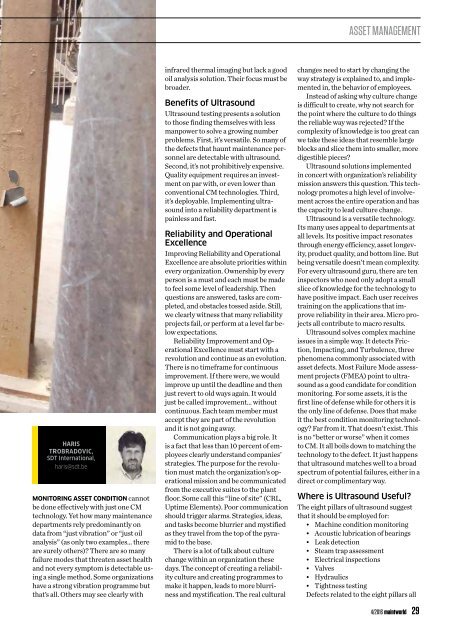Maintworld 4/2016
In this issue: Towards Better Asset Performance Modelling Paper Mills’ Planned Maintenance Approach Ultrasound in Asset Condition Management Asset Criticality Ranking
In this issue:
Towards Better Asset Performance Modelling
Paper Mills’ Planned Maintenance Approach
Ultrasound in Asset Condition Management
Asset Criticality Ranking
You also want an ePaper? Increase the reach of your titles
YUMPU automatically turns print PDFs into web optimized ePapers that Google loves.
ASSET MANAGEMENT<br />
HARIS<br />
TROBRADOVIC,<br />
SDT International,<br />
haris@sdt.be<br />
MONITORING ASSET CONDITION cannot<br />
be done effectively with just one CM<br />
technology. Yet how many maintenance<br />
departments rely predominantly on<br />
data from “just vibration” or “just oil<br />
analysis” (as only two examples… there<br />
are surely others)? There are so many<br />
failure modes that threaten asset health<br />
and not every symptom is detectable using<br />
a single method. Some organizations<br />
have a strong vibration programme but<br />
that’s all. Others may see clearly with<br />
infrared thermal imaging but lack a good<br />
oil analysis solution. Their focus must be<br />
broader.<br />
Benefits of Ultrasound<br />
Ultrasound testing presents a solution<br />
to those finding themselves with less<br />
manpower to solve a growing number<br />
problems. First, it’s versatile. So many of<br />
the defects that haunt maintenance personnel<br />
are detectable with ultrasound.<br />
Second, it’s not prohibitively expensive.<br />
Quality equipment requires an investment<br />
on par with, or even lower than<br />
conventional CM technologies. Third,<br />
it’s deployable. Implementing ultrasound<br />
into a reliability department is<br />
painless and fast.<br />
Reliability and Operational<br />
Excellence<br />
Improving Reliability and Operational<br />
Excellence are absolute priorities within<br />
every organization. Ownership by every<br />
person is a must and each must be made<br />
to feel some level of leadership. Then<br />
questions are answered, tasks are completed,<br />
and obstacles tossed aside. Still,<br />
we clearly witness that many reliability<br />
projects fail, or perform at a level far below<br />
expectations.<br />
Reliability Improvement and Operational<br />
Excellence must start with a<br />
revolution and continue as an evolution.<br />
There is no timeframe for continuous<br />
improvement. If there were, we would<br />
improve up until the deadline and then<br />
just revert to old ways again. It would<br />
just be called improvement… without<br />
continuous. Each team member must<br />
accept they are part of the revolution<br />
and it is not going away.<br />
Communication plays a big role. It<br />
is a fact that less than 10 percent of employees<br />
clearly understand companies’<br />
strategies. The purpose for the revolution<br />
must match the organization’s operational<br />
mission and be communicated<br />
from the executive suites to the plant<br />
floor. Some call this “line of site” (CRL,<br />
Uptime Elements). Poor communication<br />
should trigger alarms. Strategies, ideas,<br />
and tasks become blurrier and mystified<br />
as they travel from the top of the pyramid<br />
to the base.<br />
There is a lot of talk about culture<br />
change within an organization these<br />
days. The concept of creating a reliability<br />
culture and creating programmes to<br />
make it happen, leads to more blurriness<br />
and mystification. The real cultural<br />
changes need to start by changing the<br />
way strategy is explained to, and implemented<br />
in, the behavior of employees.<br />
Instead of asking why culture change<br />
is difficult to create, why not search for<br />
the point where the culture to do things<br />
the reliable way was rejected? If the<br />
complexity of knowledge is too great can<br />
we take these ideas that resemble large<br />
blocks and slice them into smaller, more<br />
digestible pieces?<br />
Ultrasound solutions implemented<br />
in concert with organization’s reliability<br />
mission answers this question. This technology<br />
promotes a high level of involvement<br />
across the entire operation and has<br />
the capacity to lead culture change.<br />
Ultrasound is a versatile technology.<br />
Its many uses appeal to departments at<br />
all levels. Its positive impact resonates<br />
through energy efficiency, asset longevity,<br />
product quality, and bottom line. But<br />
being versatile doesn’t mean complexity.<br />
For every ultrasound guru, there are ten<br />
inspectors who need only adopt a small<br />
slice of knowledge for the technology to<br />
have positive impact. Each user receives<br />
training on the applications that improve<br />
reliability in their area. Micro projects<br />
all contribute to macro results.<br />
Ultrasound solves complex machine<br />
issues in a simple way. It detects Friction,<br />
Impacting, and Turbulence, three<br />
phenomena commonly associated with<br />
asset defects. Most Failure Mode assessment<br />
projects (FMEA) point to ultrasound<br />
as a good candidate for condition<br />
monitoring. For some assets, it is the<br />
first line of defense while for others it is<br />
the only line of defense. Does that make<br />
it the best condition monitoring technology?<br />
Far from it. That doesn’t exist. This<br />
is no “better or worse” when it comes<br />
to CM. It all boils down to matching the<br />
technology to the defect. It just happens<br />
that ultrasound matches well to a broad<br />
spectrum of potential failures, either in a<br />
direct or complimentary way.<br />
Where is Ultrasound Useful?<br />
The eight pillars of ultrasound suggest<br />
that it should be employed for:<br />
• Machine condition monitoring<br />
• Acoustic lubrication of bearings<br />
• Leak detection<br />
• Steam trap assessment<br />
• Electrical inspections<br />
• Valves<br />
• Hydraulics<br />
• Tightness testing<br />
Defects related to the eight pillars all<br />
4/<strong>2016</strong> maintworld 29

















